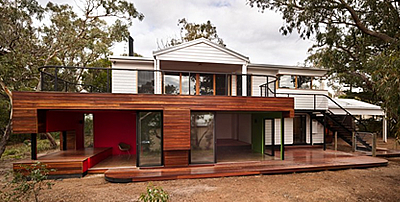What is weatherboard or wood cladding?
Timber is a classic choice for exterior wall cladding, and is normally installed by hanging planks or boards either vertically or horizontally. Other terms for weatherboard include wood cladding, clapboard, bevel siding and lap siding. Wooden shingles may also be used as an exterior wall finish.

Image courtesy of Maynard Architects.
Why install weatherboard?
The price and availability of weatherboard makes it very popular as a wall cladding. It's also very versatile, which means it can be used to create many different styles of homes. For a rustic look, for example, some people choose to leave the weatherboards in their natural state, simply applying a coat of oil to help with waterproofing. Modern homes might use a stain to colour the timber, or the boards can be painted and trimmed to suit a Victorian style house.
Wood clad homes are reasonably durable. Oiling, staining and painting wood helps to prevent rot, and as long as the building has a good building envelope with a properly functioning vapour layer there's no reason wood cladding should have any serious problems with rot, mould or mildew. Often building the bottom metre or so with a different material helps to prevent rot and other water-related problems.
Although fire and some extreme weather conditions are a problem for weatherboard homes, they do stand up well to earthquakes. Like other types of cladding, weatherboards aren't fantastic as insulators on their own, but extra insulation can be used anyway. If you're looking for a natural and environmentally friendly home, untreated recycled timber might be a good choice.
How is weatherboard installed?
In a typical timber frame house, the frame of the house is put together first. Once the frame is complete, it's sheathed in a layer of plywood, chipboard, polystyrene or some other thin, flexible material, which then has a waterproof barrier attached to it. The weatherboard is then nailed or otherwise joined to the studs, sheath and waterproofing.
Weatherboard cladding is normally made up of long, rectangular timber panels, which are attached to the exterior of a house in a horizontal overlapping pattern. Boards and panels can be installed vertically, but the horizontal pattern helps any moisture to roll nicely off the timber.
Maintenance
Timber does need to be painted, stained and oiled quite regularly. Your walls should be checked at least once or twice a year for mould, mildew and rot. Timber is relatively easy to maintain as it is such a widely used material.
|
Advantages
|
Disadvantages
|





